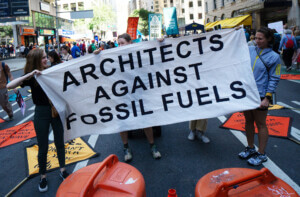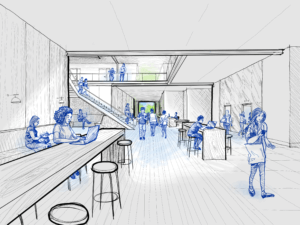Among students at the Yale School of Architecture (YSoA), associate dean Phil Bernstein is casually referred to as the Prophet, a tribute to his early work on BIM and his general prescience about the state of the industry. In a recent talk about the effect of COVID-19 on the architecture profession, he claimed that moments of crisis in architecture have historically to led “generational shifts,” suggesting the current crisis could “end the reign of the baby boomers” and lead to the establishment of a new normal.
In this crisis, there are competing ideas of what this new normal will be. Two dominant visions exist—the business-as-usual perspective, where these events are a hiccup in an otherwise continuous sequence, and the technological positivist perspective, where moving everything online represents a leap forward in the discipline’s evolution. In our response to the present crisis and its effect on our education, YSoA students have organized around another vision: A collective organizing model based on participatory decision-making. Our advocacy for our needs as students is based in mutual support and collaboration with an insistence on equity. If Phil Bernstein is right, and this crisis will affect a generational shift, our collective process is the model for our new normal.
Stretching back to the 1960s, YSoA has been regarded as the pluralist architecture school where competing ideas are invited to co-exist. Our initial student survey about the transition to online education and the administration’s handling of COVID-19 exemplified the productive messiness of pluralism. In just a few days, the survey garnered responses from around 70 percent of the student body and provided an essential place for people to reflect on their current condition. At first glance, it seemed like no one agreed on much. Even though almost all respondents said that teleworking would have a negative effect on their education, there was significant divergence as to why, or what the redress might be. Some of the respondents argued for financial compensation:
I will leave school being far more impacted by the knowledge gained by stumbling into unprompted side conversations/debates amongst classmates than I will from listening to a lecture. These invaluable assets have been robbed from us for the second half of the semester. We should receive some type of compensation for an extremely negatively altered semester.
Others were concerned about mental health:
General mental health has been compromised as all the things we seek out to help us maintain a healthy work life have been taken away. In conjunction with sustained high expectations for the rest of the semester, this will no doubt have an extremely negative affect on some students, if it hasn’t already.
Some urged patience:
This situation is not a personal attack on anyone. Our faculty is likely losing work outside of Yale; people are literally dying. We will endure hardship, but most likely not the worst of it; please maintain perspective.
And a few of the responses kept it simple:
I know you tried.
The richness of the survey responses stood in contrast to the paucity of the administration’s response thus far. From the tangle of the 150 student submissions, some general patterns emerged: A concern for the declining quality of education, a call for additional financial or physical resources, and for additional career guidance. These reflections were synthesized into a collaboratively written letter which, together with the unedited survey responses, was sent to all of YSoA on the first day of online instruction. Instead of reducing the survey responses to a lowest common denominator, our process embraced the difficult whole. Beyond sharing and framing the survey results, the letter insisted on equity and empathy:
“This letter contains many voices, but we are all unified by a single ethic—that resources be generously allocated to those most in need and most affected by the crisis in order to ensure that our education continues in an equitable way. Some of us have personal or family resources to put towards our transition to online education while other of us do not. But one thing, oft-repeated at 3 a.m. in Rudolph Hall, is doubly true in this crisis—all of us are in this together.”
The administration’s response came a little over a week later. Dean Deborah Berke’s letter restated previous commitments while rejecting proposals for equitable financial redress, health care extensions, and future facility access. YSoA offered additional lectures on professional development and the economy. Earlier on, the school had distributed laptops to some students without a computer at home. The feeling of many students, though, was expressed by a meme on a YSoA-adjacent Instagram account that summarized the administration letter as “1. Sorry 2.We 3. Can’t 4. Help 5. You.”
To continue the conversation started by the survey, dean Berke offered to meet with an elected committee of four student representatives. There was little interest in this proposal because the wider collaborative process, though rough around the edges, had proved effective in getting the breadth of student concerns heard. Sensing that the initiative to move forward would have to come from below, a group of first-year students decided to hold a ‘Zoom-Out’ to gain a wider perspective. Half sit-in and half town hall, this meeting (held over Zoom) was scheduled during studio the next day. By holding this meeting during class time, students sought to demonstrate that their response to this crisis was integral to their education. The student response put forward an alternative to top-down models of architectural pedagogy by practicing horizontal forms of consensus and solidarity.
A few days after the first-year town hall, sensing that their call for representatives had missed the point, the administration asked to hold a series of discussions with students. These talks have taken place over the last few days and student participation has stayed widely collaborative, with students volunteering to voice a specific concern or to relay questions from questioners.
These processes are ongoing and, like the crisis, they don’t seem to be abating soon. While this collaborative organizing happens in universities, parallel efforts are underway in the profession. The symmetry between the academic and professional settings is apparent now more than ever. Students at YSoA with partners or spouses who are practicing architects are now working side-by-side in the same home office. The move to telework in academic settings exactly follows the same move in the professional practice of architecture.
The response to the crisis by Yale University, as well as many architecture firms, shifts costs onto students and workers while abdicating responsibility for these changes. In the working world, this response amplifies the precarity of the architectural worker, whose at-will employment now takes place in their own home, often on their own computer, and often with their own software. In academic settings, where students from diverse backgrounds engage in shared education, the response threatens to increase the inequity that education claims to combat, as students of means can complete projects that those without sufficient resources cannot.
These situations are structural conditions and not only individual miseries. Accordingly, they deserve a collective response. The work of The Architecture Lobby, which has strong associations with YSoA, has done important work in formulating what this response may be within the profession of architecture. Our current work at YSoA puts forward a similar vision of solidarity and collective action. The previous generation at YSoA advocated for a pluralism of style and critical modes; we seek a polyphony of voices within a collective approach to organizing and architectural practice. A generational shift can’t happen soon enough.
This letter, and our organizing, is animated by our remembrance of Michael Sorkin. “Don’t mourn, organize!”











